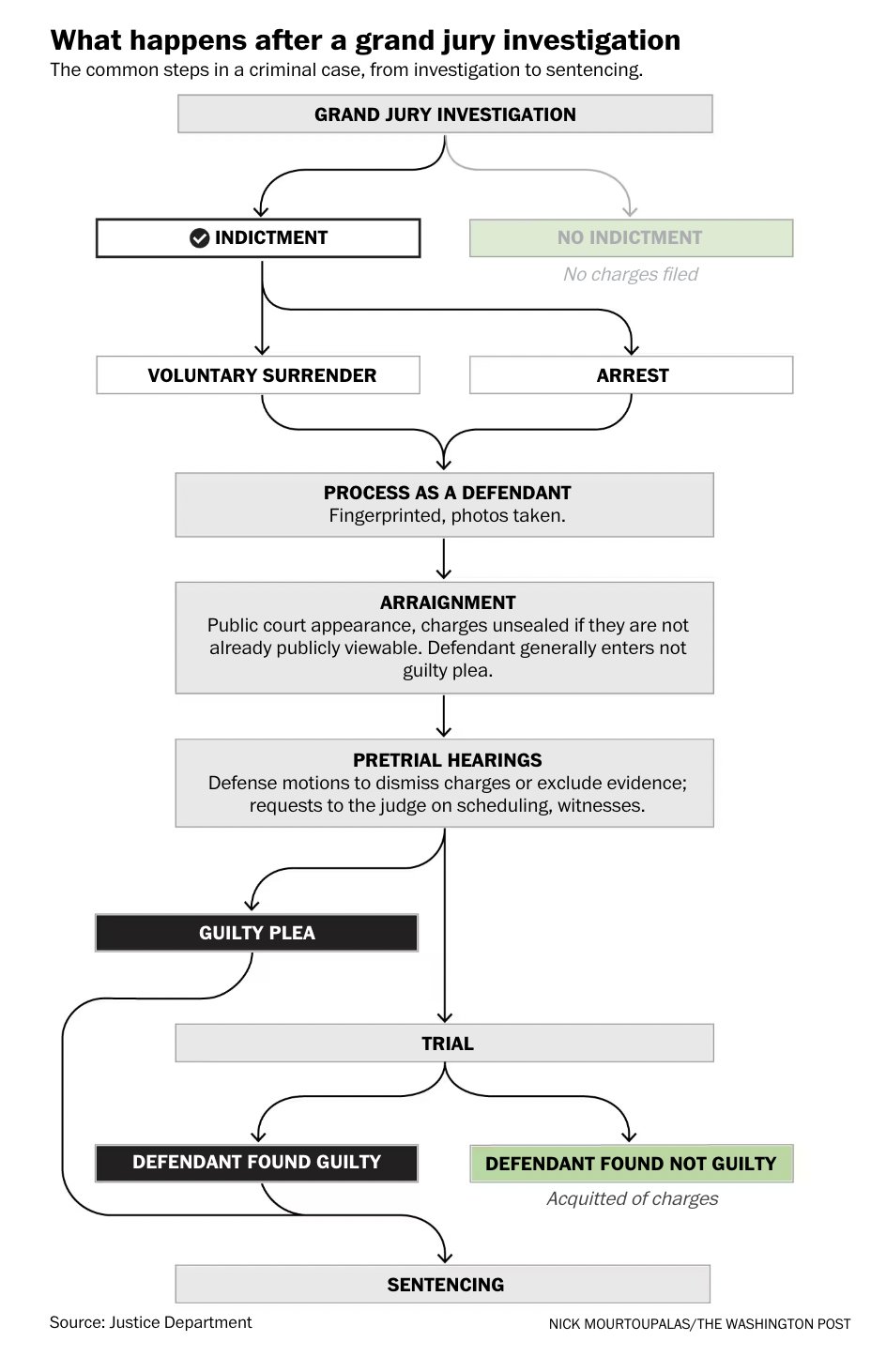After a grand jury indictment, the defendant must be arraigned on the charges. This involves appearing in court to enter a plea of guilty, not guilty, or no contest.
The process of arraignment, bail proceedings, and pretrial conferences typically follows the indictment. The grand jury must file the indictment with the County Court, and the defendant must be arraigned on the charges. Once the arraignment occurs, the case will proceed to pretrial conferences, and eventually, a trial.
It’s important to note that an indictment does not necessarily mean a guilty verdict, but rather that there is enough evidence to formally charge the defendant with a crime. It’s also worth mentioning that in some cases, a defendant may choose to waive indictment and proceed directly to trial.

Credit: twitter.com
Introduction To Grand Jury Indictments
The Role Of A Grand Jury
A grand jury is responsible for determining whether there is enough evidence to bring formal criminal charges against an individual. It is a group of citizens selected to examine the evidence presented by prosecutors and decide if a trial is warranted.
Indictment Vs. Charge
Being charged with a crime means an accusation has been made, while an indictment is a formal charge issued by a grand jury based on the evidence presented. An indictment indicates that the grand jury believes there is enough evidence to proceed to trial.
Post-indictment Procedures
After a grand jury indictment, certain legal procedures are set in motion. These procedures ensure that the defendant is informed of the charges and is provided with the opportunity to enter a plea.
Filing The Indictment
Following the grand jury’s decision to indict, the formal criminal charge, known as the indictment, is filed with the County Court. This document outlines the specific charges against the defendant and initiates the next steps in the legal process.
Defendant’s Initial Appearance
Shortly after the indictment is filed, the defendant is brought before a judge for an initial appearance. During this proceeding, the charges are formally presented, and the defendant is given the opportunity to enter a plea of guilty, not guilty, or nolo contendere (no contest).
Arraignment And Plea Entry
After the grand jury indictment, the next step in the criminal procedure is the arraignment and plea entry. This is a crucial stage in the legal process where the defendant is formally informed of the charges and is required to enter a plea.
Understanding Arraignment
Arraignment is the court proceeding where the defendant appears before a judge to hear the charges brought against them. The judge will ensure that the defendant understands the charges and their rights, including the right to legal counsel. During the arraignment, the defendant will be asked to enter a plea, typically either guilty, not guilty, or no contest.
Plea Options For The Defendant
Once the charges have been presented, the defendant has several plea options:
- Guilty: By entering a guilty plea, the defendant admits to the charges and accepts the consequences.
- Not Guilty: A plea of not guilty indicates that the defendant denies the charges and requests a trial to contest the allegations.
- No Contest (Nolo Contendere): This plea is neither an admission of guilt nor a denial. It indicates that the defendant does not contest the charges and accepts the punishment without formally admitting guilt.
It’s important for the defendant to carefully consider their plea, as it can significantly impact the subsequent legal proceedings and potential outcomes.
Bail And Pretrial Release
After a grand jury indictment, the accused individual’s next steps involve bail and pretrial release. Understanding the process and requirements for setting bail and conditions for pretrial release is crucial during this stage of the legal proceedings.
Setting Bail
Bail refers to the monetary amount set by the court to secure the release of the accused individual from custody pending trial. The purpose of bail is to ensure the defendant’s appearance in court and to protect the community from potential harm. The court takes into account various factors such as the severity of the crime, the defendant’s criminal history, and the likelihood of them fleeing before trial when setting the bail amount.
Conditions For Pretrial Release
Conditions for pretrial release are requirements set by the court that the defendant must adhere to while released from custody before trial. These conditions may include regular check-ins with a pretrial services officer, travel restrictions, electronic monitoring, drug testing, and restrictions on firearm possession. The court imposes these conditions to ensure the defendant’s compliance with the law and to mitigate potential risks to the community.
Discovery Process And Evidence
After a grand jury indictment, the discovery process and evidence play a critical role in the legal proceedings. Both the defense and the government have specific rights and obligations regarding the access to evidence and disclosure of information.
Defense’s Access To Evidence
Following an indictment, the defense has the right to request access to the evidence that the government plans to use in the case. This includes documents, witness statements, and any other materials that may be relevant to the defense strategy. The defense team can review the evidence to prepare their case effectively and ensure a fair trial.
Government’s Disclosure Obligations
Upon indictment, the government has a legal duty to disclose all exculpatory evidence to the defense. This includes any evidence that could potentially favor the defendant or undermine the prosecution’s case. The government must also provide witness lists, expert reports, and any other information that may be used at trial.

Credit: www.reddit.com
Pretrial Motions And Hearings
When a grand jury hands down an indictment, the defendant enters the pretrial phase of the legal process. During this stage, various pretrial motions and hearings take place, shaping the course of the upcoming trial.
Types Of Pretrial Motions
Pretrial motions are formal requests made by the defense or prosecution to the court, addressing specific legal issues before the trial begins. These motions serve to clarify legal matters, suppress evidence, or dismiss the case.
Purpose Of Pretrial Hearings
Pretrial hearings are conducted to address various matters, such as plea bargains, evidence admissibility, and setting trial dates. These hearings aim to resolve key legal issues and streamline the trial process.
The Trial Phase
After a grand jury indictment, the trial phase begins. The defendant is arraigned on the indictment, and the process of bail proceedings, discovery, and pretrial motions begins. The indictment is a formal criminal charge, and a unanimous verdict is required to find the defendant guilty or not guilty.
Jury Selection
During the trial phase, the first crucial step is the jury selection process. Both the prosecution and defense attorneys have the opportunity to question potential jurors to ensure a fair and impartial jury for the trial. This process aims to select individuals who can weigh the evidence objectively and reach a fair verdict.
Opening Statements
Following the jury selection, the trial proceeds with opening statements. Here, the prosecution and defense present an overview of their cases to the jury. The opening statements serve to outline the evidence and arguments that will be presented throughout the trial, setting the stage for the proceedings to come.
Witness Testimony
Subsequently, the trial advances to the phase of witness testimony. Both sides have the opportunity to call witnesses to provide evidence and testimony relevant to the case. Witness testimony plays a crucial role in shaping the jury’s understanding of the events in question and can significantly impact the outcome of the trial.
Potential Outcomes
After a grand jury indictment, several potential outcomes may unfold based on the legal proceedings. These outcomes can range from plea bargains to trial verdicts and sentencing scenarios.
Plea Bargains
Plea bargains are negotiated agreements between the prosecution and the defendant, where the defendant agrees to plead guilty in exchange for a lesser charge or a more lenient sentence.
Trial Verdicts
Trial verdicts are decisions made by a judge or jury at the conclusion of a trial. The verdict can be either guilty or not guilty based on the evidence presented during the trial.
Sentencing Scenarios
Sentencing scenarios refer to the range of possible penalties that a defendant may face if found guilty. Sentencing can include fines, probation, community service, or incarceration.
Post-trial Options
After a grand jury indictment, the defendant is arraigned on the charges, and post-trial options become available. The defendant can either plead guilty, go to trial, or negotiate a plea bargain with the prosecution. It is important to have a skilled criminal defense attorney to guide you through the legal process and ensure the best possible outcome.
After a grand jury indictment, the legal process continues with post-trial options available to the defendant. These options include the appeals process, writs, and post-conviction relief.
Appeals Process
In the appeals process, the defendant can challenge the verdict by requesting a higher court to review the trial proceedings for legal errors. Appeals focus on procedural mistakes or misapplication of law rather than the factual guilt or innocence of the defendant.
Writs And Post-conviction Relief
Writs and post-conviction relief provide avenues for the defendant to seek relief from a conviction or sentence after exhausting the appeals process. These options typically involve presenting new evidence, alleging constitutional violations, or claiming ineffective assistance of counsel.
In summary, post-trial options such as the appeals process, writs, and post-conviction relief offer avenues for defendants to challenge their convictions or sentences following a grand jury indictment.

Credit: www.reddit.com
Implications Of A No Bill Decision
When a grand jury issues an indictment, it signifies a formal criminal charge has been brought against the accused individual. However, there are instances where the grand jury decides not to indict, known as a ‘No Bill’ decision. Understanding the implications of a ‘No Bill’ decision is crucial.
Understanding ‘no Bill’
When a grand jury returns a ‘No Bill’, it means they have not found enough evidence to proceed with a formal criminal charge. This decision does not necessarily mean the accused is innocent, but rather that the case lacks sufficient evidence for prosecution.
Consequences For The Accused
- A ‘No Bill’ decision can lead to the accused individual being released from custody if they were detained pending the grand jury’s decision.
- The accused may not face trial or any further legal proceedings related to the specific charges mentioned in the ‘No Bill’ decision.
- However, it’s essential to note that a ‘No Bill’ decision does not prevent authorities from pursuing other charges or reopening the case if new evidence emerges.
Frequently Asked Questions
Is An Indictment Returned By A Grand Jury?
Yes, an indictment is returned by a grand jury after deciding if there is enough evidence for formal criminal charges.
Which Step In A Criminal Procedure Comes After An Indictment By A Grand Jury Quizlet?
After an indictment by a grand jury, the next step is the defendant’s arraignment in court.
What Is The Difference Between Charge And Indictment?
A charge is an accusation, while an indictment is a formal criminal charge issued by a grand jury.
When A Grand Jury Issues An Indictment, This Means That _____?
An indictment by a grand jury means that there is enough evidence to formally charge the person with a crime.
Conclusion
After a grand jury indictment, the legal process moves forward with an arraignment and trial preparation. The defendant faces the formal criminal charges and begins building their defense strategy. Understanding the steps post-indictment is crucial for all parties involved in the criminal justice system.